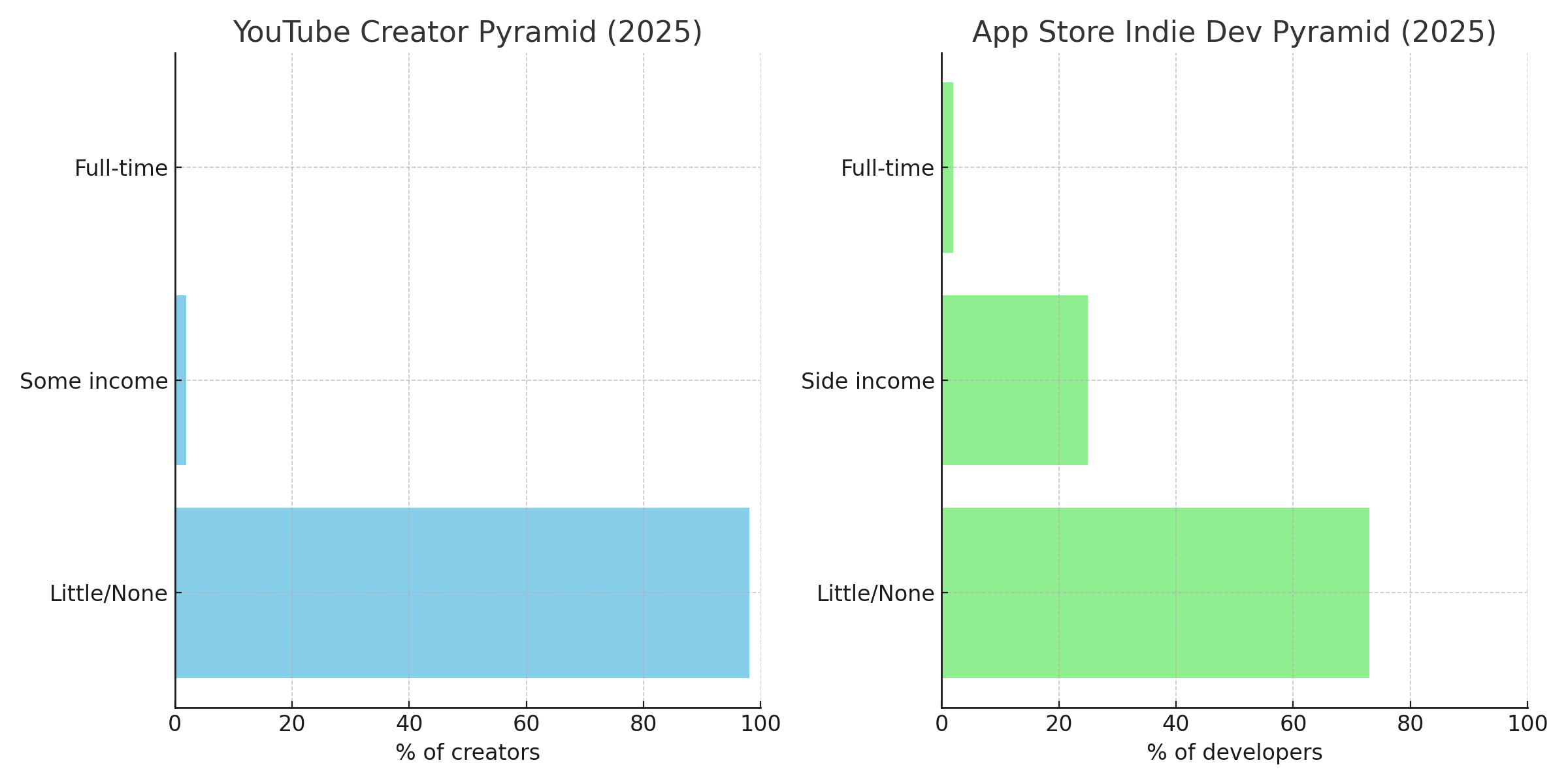YouTube Creators vs App Store Developers
This is a comparison between two major digital creator ecosystems.
On one side are the YouTube creators, who build a business by harnessing a platform’s powerful algorithm to reach a wide audience. Their success is a function of engagement, trends, and the ever-shifting landscape of a third-party platform.
On the other side stand the App Store developers, who forge a business by building a proprietary product from the ground up. Their work, though often slower to gain momentum, creates a tangible digital asset they own and control, independent of a platform’s whims.

While both fields are governed by a pyramid structure where a small elite earns the most, the distribution of wealth is starkly different.
On YouTube, the winner-takes-all dynamic is dominant, with a massive base of creators (over 98%) earning little to no income from their efforts. A small minority (1–2%) manage to generate a side income of a few hundred dollars per month, often struggling for consistent growth in a highly saturated market. The top tier is a tiny elite, comprising a mere 0.1% of all creators, who achieve a full-time living by consistently producing heavy content, a grueling process that often takes years.
In contrast, the world of app development on platforms like the App Store presents a more evenly spread economic model. Although the majority of developers still earn little, the middle class is significantly more robust.
A healthy 20–30% of active developers generate a solid side income by creating apps that solve specific, tangible problems. While the top tier is smaller (1–3% of developers), they often achieve a higher income bracket than their YouTube counterparts by focusing on strong product development and consistent updates.
This key difference highlights that while YouTube success is heavily reliant on a few viral hits and algorithmic favor, App Store offers a more reliable path to a sustainable middle-class income.
How to make money?
The way each makes money is perhaps their greatest difference. YouTube creators, particularly at the bottom of the pyramid, are heavily dependent on AdSense revenue, which is notoriously low and unstable. For those at the top, income is diversified through sponsorships, merchandise sales, and fan funding platforms like Patreon. This revenue is often a direct result of their personal brand and audience engagement.
In contrast, developers have a more product-based revenue model. Their income comes directly from the app itself, through premium app purchases, subscriptions, or in-app purchases. This gives them more direct control over pricing and monetization strategies. While many apps also rely on advertising, the core business is selling a tangible product, not just viewer attention.
What do they actually do?
Both paths demand being a “jack-of-all-trades,” but in completely different domains.
A successful creator is part videographer, part editor, part performer, and part marketer. Their day-to-day work involves conceptualizing content, filming, editing, and promoting videos, all while cultivating a personal brand.
Creators face the relentless pressure of the content calendar - the algorithm rewards consistent uploads, so taking breaks can hurt reach. Their grind is visible and social.
A developer’s work involves writing code, debugging, creating seamless user flows, and responding to user feedback with updates and new features.
Developers can work in relative obscurity for months, with their grind being largely invisible until launch. But then they face the brutal reality of app store competition where timing, luck, and market fit matter enormously.
Both paths require extraordinary persistence, but creators get real-time feedback (views, comments, likes) while developers often work in a feedback vacuum until release.
The psychological resilience needed for each is quite different - creators need thick skin for public criticism, while developers need tolerance for technical frustration and market uncertainty.
Who’s really in charge?
This is the most critical difference between the two models. A YouTube channel’s success is at the mercy of the platform’s algorithm. A change to YouTube’s recommendation system or monetization policies can wipe out a creator’s income overnight. The content they create is an asset, but it is “rented” on a platform they do not control.
Conversely, a developer owns their core asset: the codebase of their app. While they are subject to App Store policies, they have far greater control over their product’s features, updates, and future. The intellectual property and code are theirs to modify, sell, or even port to other platforms, providing a more stable and enduring foundation for their business.